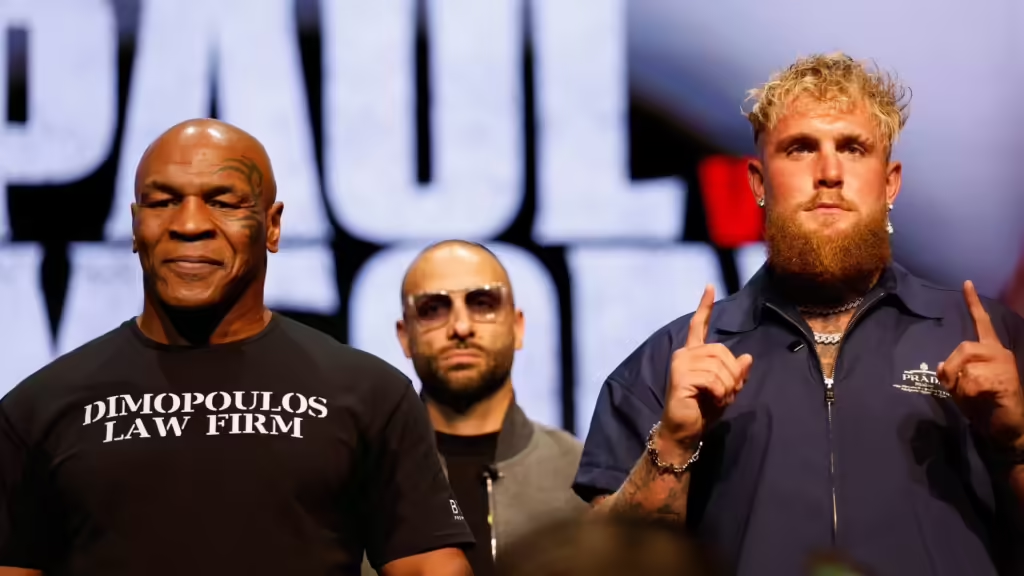The upcoming fight between Mike Tyson and Jake Paul on Friday, November 15 at AT&T Stadium in Texas is much more than a boxing match; it’s a huge media event blending the legacy of a heavyweight legend with the influence of a digital-era star.
The event is scheduled to begin at 8pm local time (2:00am GMT + 1 on November 16).
Tyson, a dominant force in boxing since the 1980s, brings his legendary power and presence.
Meanwhile, Paul, an internet sensation turned boxer, draws in a younger audience. Together, they’re creating a unique crossover event that merges sports tradition with modern entertainment.
As the Tyson vs. Paul’s fight draws near, we explore why this bout is significant for boxing, the business potential behind it, and what it could mean for sports streaming with Netflix in the mix. More than a spectacle, this event is a test case for blending the worlds of legacy sports and influencer-driven entertainment, while also marking Netflix’s first major move into live sports.
The fight reflects a changing media landscape, with implications for how sports generally might be promoted and streamed in the future.
The business of boxing meets the age of streaming
For Netflix, streaming the Tyson-Paul fight is its first major step into live sports, challenging established networks like ESPN and DAZN. This move helps diversify its content offering and attract a younger, influencer-driven audience.
- The event’s broad appeal could lead to a surge in subscribers, as it reaches viewers who may not typically follow boxing but are drawn in by the personalities involved and the exclusivity of the event. It’s a strategic push to engage beyond traditional programming and into more mainstream entertainment.
- To generate buzz around the fight, Netflix released Countdown: Paul vs. Tyson, a three-part documentary series showcasing the fighters’ preparations. The series highlights Tyson’s return to the ring and Paul’s unconventional rise as a boxer.
Jake Paul’s promotional company, MVP, leverages his media presence and business instincts, while the series also taps into Tyson’s enduring legacy. This strategy effectively blends both fighters’ personal stories, adding depth and anticipation to the upcoming bout.
A convergence of generational audiences
This fight, dubbed the “clash of eras,” merges traditional boxing with the influence of modern social media culture. Tyson represents a nostalgic era of boxing dominance, while Paul embodies the new wave of digital fame and interactive engagement.
- Although the idea of a crossover event isn’t entirely new, Netflix’s involvement on such a global stage makes it unique. This fight appeals to fans of both old-school boxing and the younger generation raised on influencers and online personalities, creating a rare blend of sports and entertainment.
- This fight has the potential to redefine boxing’s place in modern entertainment, showing how the sport can expand beyond its traditional audience.
By blending the legacy of boxing with new media influences, it may pave the way for other sports to reach a broader, more diverse viewership—drawing in fans who are more interested in the spectacle and evolving nature of sports entertainment than the sport’s traditional roots.
The financial stakes and market impact of the fight
The financial impact of the Tyson-Paul fight is immense, with VIP packages selling for up to $2 million. These exclusive tickets offer luxury experiences like premium seating and meet-and-greets with the fighters, catering to wealthy individuals seeking more than just a standard sporting event.
- This high-profile clash is expected to generate substantial revenue, tapping into both the luxury and celebrity markets, demonstrating how fights with broad appeal can attract high-net-worth audiences beyond the typical boxing fan.
- Jake Paul’s experience in influencer marketing has turned the Tyson-Paul fight into a media spectacle, combining high-end sponsorships with aggressive social media outreach.
Both MVP and Netflix have crafted promotions that make boxing more appealing to a broader audience. For advertisers, the event offers significant brand exposure, from the documentary series leading up to the fight to the live events during fight week, ensuring sponsors are at the forefront of the action.
Redefining boxing’s appeal and future
While some might argue that influencer boxing undermines the sport, the Tyson-Paul fight demonstrates how athleticism and branding can coexist.
- Although traditionalists may view Paul as an outsider, his ability to generate massive viewership shows that boxing can appeal to a broader audience. The event blends sport, celebrity, and influencer culture, proving that both seasoned athletes and non-traditional figures can succeed in today’s boxing landscape.
- For Netflix, the success of the Tyson-Paul fight could open doors for future live-streamed events, not just in boxing but across other sports.
The model could inspire more collaborations that mix sports nostalgia with modern appeal, attracting fans from different generations and reshaping how sports events are marketed and consumed in the digital age.
What are the implications for sports media and business?
Tyson vs. Paul is more than just a fight. It’s a pivotal moment for Netflix. As the streaming giant’s first live sports event, it’s testing how well sports content resonates with subscribers. Success could set a precedent for future events that blend traditional sports with digital media, opening up new ways to engage diverse audiences and transforming how legacy sports are marketed in the streaming era.
The Tyson-Paul fight merges the legacies of two contrasting figures, turning a potentially niche event into a major spectacle. It represents the future of sports, where digital media influences how we experience live events. This isn’t just about the fight; it’s about how platforms like Netflix are reshaping the sports landscape. Its impact could extend beyond Netflix, signaling the start of an era where streaming and the excitement of live sports are inseparable.
